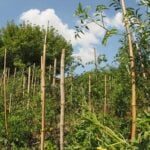When it comes to building projects, CCA treated wood is a commonly used material due to its resistance to decay and insects. However, there is growing concern about whether or not this type of wood is safe for use in vegetable gardens. Many gardeners and homeowners are asking the question, “is CCA treated wood safe for vegetable gardens?”.
CCA treated wood, short for chromated copper arsenate, is a type of timber that has been infused with chemicals to protect it from rotting and insect damage. This treatment process involves using a combination of copper, chromium, and arsenic compounds to create a durable and long-lasting material. As a result, CCA treated wood has been widely used in outdoor construction projects such as decks, fences, and raised garden beds.
While the use of CCA treated wood offers practical benefits in terms of durability and longevity, concerns have been raised about the potential risks associated with using this type of wood in vegetable gardens. There is apprehension over the possibility of harmful chemicals leaching into the soil and subsequently being absorbed by vegetables grown in close proximity to CCA treated wood.
In this article, we will explore these concerns in depth and provide information on alternative materials as well as safety measures that can be taken when using CCA treated wood in vegetable gardens.
What Is CCA Treated Wood?
Chemical Composition
CCA treated wood is wood that has been treated with a combination of chromium, copper, and arsenic to protect it from decay and insect damage. The chemicals in CCA treated wood penetrate the wood fibers, creating a barrier against rot and pests.
Treatment Process and Purpose
The process of treating wood with CCA involves placing the wood in a pressurized cylinder and applying the chemical solution. This allows the chemicals to deeply penetrate the wood, making it resistant to deterioration. CCA treated wood is commonly used for outdoor construction projects such as decks, fences, and retaining walls due to its durability and longevity.
Potential Risks in Vegetable Gardens
Despite its effectiveness in preventing decay and pest infestations, using CCA treated wood in vegetable gardens raises concerns about the potential leaching of harmful chemicals into the soil. There is also a risk of these chemicals being absorbed by plants and subsequently consumed by humans through contaminated vegetables. The question “is CCA treated wood safe for vegetable gardens” is justified given these potential risks.
As an alternative to using CCA treated wood in vegetable gardens, there are eco-friendly options like untreated cedar or redwood that can offer similar durability without exposing your garden to harmful substances such as arsenic or chromium. It’s essential to prioritize safety when cultivating food at home, so taking extra precautions by avoiding potentially hazardous materials like CCA treated wood can provide peace of mind for you and your family.
Potential Risks of Using CCA Treated Wood in Vegetable Gardens
Leaching of Harmful Chemicals
CCA treated wood contains chemicals such as copper, chromium, and arsenic, which are used to preserve the wood and protect it from decay caused by insects and fungi. However, there is a concern that these chemicals may leach into the soil over time, especially in moist conditions.
This can potentially contaminate the soil and pose risks to the vegetables grown in that environment. The leaching process could be accelerated by factors such as frequent watering or heavy rainfall, making it important for gardeners to consider the potential impact on their plants.
Risks of Consuming Vegetables Grown Near CCA Treated Wood
Another significant risk associated with using CCA treated wood in vegetable gardens is the potential absorption of harmful chemicals by the plants. If the soil becomes contaminated with copper, chromium, or arsenic from the wood, there is a risk that these substances may be taken up by the vegetables themselves. This could lead to human consumption of fruits and vegetables containing elevated levels of these toxic compounds, which could have adverse effects on health.
Balanced Perspective
While there are valid concerns regarding the use of CCA treated wood in vegetable gardens, it is important to approach this issue with a balanced perspective. Research has shown that the extent of chemical leaching from CCA treated wood is influenced by various factors such as soil pH, moisture levels, and aging of the wood itself.
Additionally, not all studies have found substantial evidence of harm from using CCA treated wood in vegetable gardens. Nonetheless, it is crucial for gardeners to weigh these considerations carefully when making decisions about their garden construction materials.
Research on the Safety of CCA Treated Wood in Vegetable Gardens
When considering the use of CCA treated wood in vegetable gardens, it is important to address the potential risks and safety concerns associated with this building material. Research on the safety of CCA treated wood for use in vegetable gardens has been a topic of interest for both professionals and DIY gardeners alike.
Several studies have investigated the effects of CCA treated wood on soil and plant health, as well as the potential risks to human health from consuming vegetables grown in close proximity to this type of wood.
To provide an informed perspective on the safety of CCA treated wood in vegetable gardens, here are some of the key findings from existing research:
- Studies have found that CCA-treated wood can leach arsenic, chromium, and copper into the surrounding soil over time. These chemicals pose potential risks to both plant and human health when present in high concentrations.
- Research has also indicated that vegetables grown near CCA treated wood may absorb elevated levels of these chemicals, particularly root vegetables such as carrots and potatoes.
- While some studies suggest that the risk of exposure to harmful chemicals from CCA treated wood in vegetable gardens is low under certain conditions, others emphasize caution and recommend alternative materials.
- Consider using naturally rot-resistant woods such as cedar or redwood for raised beds
- Utilize composite materials or metal options for structural components
- Implement a protective barrier such as landscape fabric between soil and CCA treated wood
- Regularly monitor soil pH levels and conduct soil testing for any signs of chemical contamination
Ultimately, it is crucial to conduct thorough research and carefully consider all factors before using CCA treated wood in a vegetable garden. Prioritizing safety measures can help mitigate potential risks associated with this type of lumber while ensuring a healthy environment for growing produce.
Alternatives to CCA Treated Wood for Vegetable Gardens
When considering the use of CCA treated wood in vegetable gardens, it is important to explore alternative materials that can be used for garden construction. While CCA treated wood has been commonly used in the past, concerns about potential health risks have led many gardeners to seek out safer options. There are several alternatives to consider, each with its own benefits and drawbacks.
Alternative Materials for Vegetable Garden Construction
- Cedar: Cedar wood is naturally resistant to rot and insect infestation, making it a popular choice for outdoor construction projects. It is also known for its durability and attractive appearance.
- Composite lumber: Made from a blend of wood fibers and plastic, composite lumber is a low-maintenance option that is resistant to rot and decay. It is available in various colors and can be an environmentally friendly choice if made from recycled materials.
- Untreated pine: Untreated pine is a budget-friendly option for vegetable garden beds. While it may not last as long as treated wood or other alternatives, it can still be a suitable choice for temporary or small-scale gardens.
Benefits and Drawbacks of Each Alternative
- Cedar: Benefits include natural resistance to decay and insects, but drawbacks may include higher cost compared to other options.
- Composite lumber: Benefits include low maintenance and durability, but drawbacks may include potential environmental concerns related to plastic content.
- Untreated pine: Benefits include affordability, but drawbacks may include shorter lifespan compared to treated wood or other alternatives.
When considering alternatives to CCA treated wood for vegetable gardens, it is important to weigh the pros and cons of each option based on your specific gardening needs and priorities. By carefully selecting the right material for your garden construction, you can ensure a safe environment for growing healthy vegetables without compromising on structural integrity or sustainability.
Ensuring the Safety of Vegetable Gardens With CCA Treated Wood
Ensuring the safety of vegetable gardens that use CCA treated wood is a top concern for many gardeners. The primary worry is the potential leaching of harmful chemicals from the wood into the soil, which could then be absorbed by the plants. This raises questions about the safety of consuming vegetables grown in such a setting.
Research on the matter has yielded conflicting information, making it difficult for gardeners to determine whether or not CCA treated wood is safe for vegetable gardens. Some studies suggest that while small amounts of chemicals may leach from the wood, these levels are not significant enough to cause harm to humans through consumption of vegetables. However, other experts advise against using CCA treated wood altogether, especially in areas where edible plants are grown.
To ensure the safety of vegetable gardens with CCA treated wood, there are several measures that can be taken to mitigate potential risks. One approach is to line the interior of raised beds constructed with CCA treated wood with heavy-duty plastic sheeting to prevent direct contact between the soil and the wood. Additionally, using a barrier fabric or geotextile underneath raised beds can further reduce the risk of chemical leaching into the surrounding soil.
Ultimately, while there is still debate surrounding the use of CCA treated wood in vegetable gardens, it is important for gardeners to weigh the potential risks and take necessary precautions to ensure their produce remains safe for consumption. By staying informed and implementing best practices, it is possible to minimize any possible harm associated with using CCA treated wood in a vegetable garden setting.
Regulations and Guidelines for Using CCA Treated Wood in Vegetable Gardens
When it comes to using CCA treated wood in vegetable gardens, there are important regulations and guidelines that should be considered to ensure the safety of the garden and the food grown within it. One of the main concerns surrounding CCA treated wood is whether the chemicals used in the treatment process can leach into the soil and potentially contaminate the vegetables. This has led to various regulations and guidelines being put in place to address these concerns.
In the United States, the Environmental Protection Agency (EPA) has established regulations governing the use of CCA treated wood, particularly when it is intended for use in areas where it may come into contact with food crops. These regulations include specific restrictions on the use of CCA treated wood in vegetable gardens, playground equipment, and other areas where there is a risk of direct human exposure.
Additionally, many states have their own regulations regarding the use of CCA treated wood, often building upon or expanding upon federal guidelines.
Given these regulations, if you are considering using CCA treated wood in your vegetable garden, it is essential to familiarize yourself with both federal and state-specific guidelines to ensure compliance. It is important to note that while these regulations are designed to minimize potential risks, they do not eliminate them entirely.
Therefore, it’s crucial to weigh these regulations alongside other factors such as alternative materials and proper installation techniques when making decisions about constructing a vegetable garden with CCA treated wood.
| Regulatory Body | Restrictions |
|---|---|
| Environmental Protection Agency (EPA) | Specific restrictions on use of CCA treated wood near food crops |
| State Regulations | Diverse guidelines regarding use of CCA treated wood in different contexts |
Conclusion
In conclusion, the question “Is CCA treated wood safe for vegetable gardens?” is one that requires careful consideration and understanding of the potential risks involved.
While CCA treated wood has been commonly used in building projects due to its resistance to decay and insects, there are concerns about its safety when used in close proximity to vegetable gardens. The chemical composition of CCA treated wood raises questions about the potential leaching of harmful chemicals into the soil, which could then be absorbed by vegetables grown in that soil.
Research on the safety of CCA treated wood in vegetable gardens has yielded conflicting information, with some studies suggesting potential risks while others indicate that the level of exposure through consumption of produce is minimal. However, it is important to consider alternative materials for constructing vegetable gardens, such as cedar or recycled plastic lumber, which may pose fewer potential risks.
It is crucial for individuals considering the use of CCA treated wood in their vegetable gardens to thoroughly research and understand any regulations or guidelines related to its use. Additionally, implementing measures such as lining the inside of raised beds with a barrier can help mitigate potential risks associated with using CCA treated wood in vegetable gardens. Ultimately, taking these precautions and being well-informed is essential for ensuring the safety of vegetable gardens when using CCA treated wood.
Frequently Asked Questions
Is CCA Treated Pine Safe for Vegetable Gardens?
CCA treated pine is not considered safe for vegetable gardens. The chemicals used in the treatment process, such as copper, chromium, and arsenic, can leach into the soil and potentially contaminate the vegetables.
Is Copper Treated Wood Safe for Vegetable Gardens?
Copper treated wood is also not recommended for vegetable gardens. While copper has some natural anti-fungal and anti-bacterial properties, it can still release harmful substances into the soil over time, posing a risk to edible plants.
Is Treated Wood Safe for Vegetable Gardening?
Generally, treated wood is not deemed safe for vegetable gardening. The chemicals used in the treatment process can leach into the soil and be absorbed by the plants, potentially ending up in the fruits or vegetables grown in that area.
It’s best to opt for untreated wood or alternative materials when building raised beds or other structures for growing vegetables.

If you’re looking to get into vegetable gardening, or are just looking for some tips on how to make your current garden better, then you’ve come to the right place! My name is Ethel and I have been gardening for years. In this blog, I’m going to share with you some of my best tips on how to create a successful vegetable garden.





